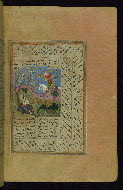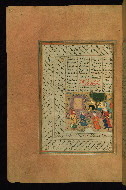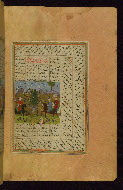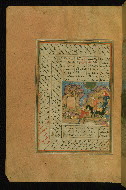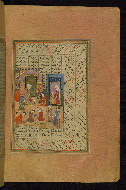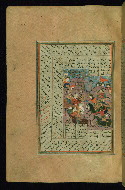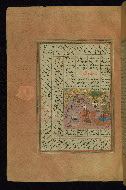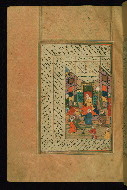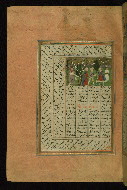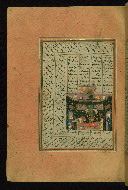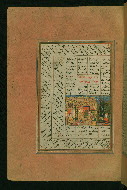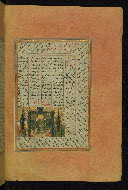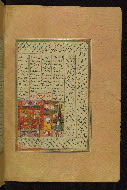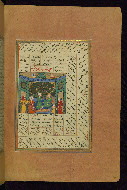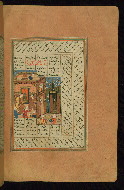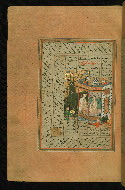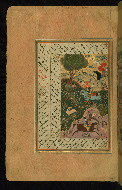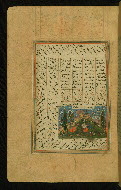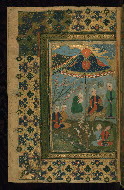Home > Digitized Walters Manuscripts
This document is a tranformation of a TEI P5 XML manuscript description incorporating images. If you have trouble reading special or non-Latin characters on this page, please make sure you have appropriate Unicode fonts installed and an up-to-date web browser.
Walters Ms. W.657, Three collections of poetry
Browse images (Browse images in a new window) | TEI in XML format
W.657
Three collections of poetry
Vernacular: خمسه نظامي
Khamsah-i DihlavīVernacular: خمسه دهلوى
Timūrnāmah-i HātifīVernacular: تيمورنامه هاتفى
Authority name: Niẓāmī Ganjavī, 1140 or 41-1202 or 3
As-written name: Ilyās ibn Yūsuf Niẓāmī Ganjavī
Name, in vernacular: الياس بن يوسف نظامي گنجوي
Note: Author dates preferred by cataloger: d. 605 AH / 1209 CE
Authority name: Amīr Khusraw Dihlavī, ca. 1253-1325
As-written name: Amīr Khusraw Dihlavī
Name, in vernacular: امير خسرو دهلوي
Note: Author dates preferred by cataloger: d. 725 AH / 1325 CE
Authority name: Hātifī, d. 1520 or 1
As-written name: ʿAbd Allāh Hātifī
Name, in vernacular: عبد الله هاتفي
Note: Author dates preferred by cataloger: d. 927 AH / 1520 CE
This is an illustrated and illuminated composite volume of three poetic texts: the Khamsah (quintet) of Niẓāmī Ganjavī (d. 605 AH / 1209 CE), the Khamsah (quintet) of Amīr Khusraw Dihlavī (d. 725 AH / 1325 CE), and the Timūrnāmah (Epic of Timur) by ʿAbd Allāh Hātifī (d. 927 AH / 1520 CE), also known as the Ẓafarnāmah. The texts are written in black naskh script, with titles, section headings, and incidentals in white or red tawqīʿ/riqāʿ script. It was produced in the tenth century AH / sixteenth CE, in either India or Safavid Iran. The binding is not original to the manuscript. According to a note on front flyleaf iia, the codex was re-bound and restored by a bookbinder of Tabriz, Khwand Mullā Mahdī Ṣaḥḥāf-i Tabrīzī in 1295 AH /1878 CE.
10th century AH / 16th CE; partial dates given on fol. 26a (last day of Ramaḍān) and fol. 214b (Shawwāl)
Iran
Book
Historical
Literary -- Poetry
The primary language in this manuscript is Persian.
Paper
Tinted laid paper: cream for text area and rose or light brown for margins
Foliation: iii+330+iii
Catchwords: Written obliquely at ends of fifth columns
19.0 cm wide by 28.0 cm high
fols. 1b - 316a: 0.0 cm wide by 0.0 cm high
fols. 1b - 282a: 0.0 cm wide by 0.0 cm high
fols. 282b - 329a: 0.0 cm wide by 0.0 cm high
- Columns: 4
- Ruled lines: 13
- Written surface within frame consisting of five columns, the first with text written obliquely, as well as a margin, also with obliquely written text; text of Khamsah-i Niẓāmī begins in second column; framing lines in orange, green, gold, black, and white
- Columns: 1
- Columns: 1
- Obliquely written text beginning in the outer area of fol. 282b and continuing in the first column (after fol. 316a occupying the other columns as well)
- Title: Khamsah-i Niẓāmī
- Author: Niẓāmī Ganjavī, 1140 or 41-1202 or 3
- Incipit: بسم الله الرحمن الرحيم هست كليد در كنج حكيم...
- Text note: Written in main text area (four columns); contains all five poems: Makhzan al-asrār, Khusraw va Shīrīn, Laylá va Majnūn, Haft paykar, and Iskandarnāmah (divided into Iqbālnāmah and Khidrnāmah)
- Hand note: Main text written in small naskh script executed in black ink; titles of works and other inscriptions in headpieces and subheadings in tawqīʿ/riqāʿ script in white or red ink
- Decoration note: Illustrations; double-page illuminated frontispiece (right side now missing); incipit pages with headpieces; titlepieces introducing various works plus smaller pieces; blank spaces and some couplets missing on fols. 175a-175b
- Title: Khamsah-i Dihlavī
- Author: Amīr Khusraw Dihlavī, ca. 1253-1325
- Incipit: بسم الله الرحمن الرحيم خطبه قدست بملك قديم...
- Text note: Obliquely written text placed in the outer area within the frame and in the first column; contains Maṭlaʿ al-anvār, Shīrin va Khusraw, Majnūn va Laylá, Āyinah-i Iskandarī, and Hasht bihisht; blank spaces and some missing couplets on fols. 175a-175b
- Hand note: Main text written in small naskh script in black ink; titles of works and other inscriptions in headpieces and subheadings in tawqīʿ/riqāʿ script in white or red ink
- Decoration note: Illustrations; various works introduced by small illuminated titlepieces
- Title: Timūrnāmah-i Hātifī
- Author: Hātifī, d. 1520 or 1
- Incipit: بنام خداۓ کہ فكر خرد...
- Text note: Subheadings not supplied
- Hand note: Main text written in small naskh script executed in black ink; titles of works and other inscriptions in headpieces and subheadings in tawqīʿ/riqāʿ script in white or red ink
- Decoration note: Illustrations; illuminated rectangular piece occupying the outer area and the first column with the inscription: Tamarnāmah-i [sic] Hātifī ʿalayhi al-raḥmah
fol. 1a:
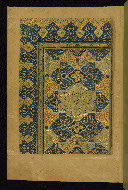
- Title: Double-page illuminated frontispiece with titlepiece
- Form: Frontispiece; titlepiece
- Label: This is the left side of a double-page illuminated frontispiece, inscribed in the central panel with the titles of the three works contained in the manuscript, as well as their locations within the frame. The facing page is now missing.
fol. 1b:
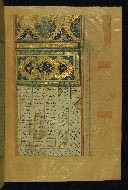
- Title: Incipit with illuminated titlepiece
- Form: Incipit; titlepiece
- Label: This illuminated titlepiece is inscribed in white tawqīʿ/riqāʿ script: Makhzan al-asrār-i Shaykh-i Niẓāmī ʿalayhi al-raḥmah. Three small triangular pieces at the beginning of the text introduce Maṭlaʿ al-anwār, the first poem of the Khamsah of Dihlavī. There is one cornerpiece with floral design.
fol. 13a:
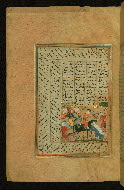
- Title: An old woman implores Sultan Sanjar for help
- Form: Illustration
- Text: Makhzan al-asrār
- Label: An old woman complains before Sultan Sanjar on horseback about feeling oppressed by his policeman.
fol. 26b:
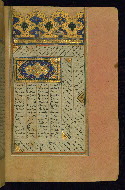
- Title: Incipit with illuminated headpiece and titlepiece
- Form: Incipit; headpiece; titlepiece
- Text: Khusraw va Shīrīn
- Label: This incipit page has two illuminated pieces, a headpiece and a titlepiece. The latter is in the lower panel, which is inscribed: Khusraw va Shīrīn-i Shaykh-i Niẓāmī.
fol. 39b:
fol. 54b:
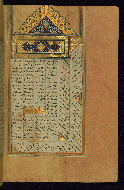
- Title: Incipit with illuminated headpiece and titlepiece
- Form: Incipit; headpiece; titlepiece
- Text: Shīrin va Khusraw
- Label: This incipit page has a few illuminated pieces. Above, there is a headpiece inscribed: huwa Allāh. At the right is a triangular piece and the inscription: Shīrin va Khusraw-i Amīr Khusraw.
fol. 62a:
fol. 69b:
fol. 70a:
fol. 100a:
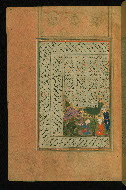
- Title: Illustrated finispiece with three men praying near a stream
- Form: Illustration; finispiece
- Text: Khusraw va Shīrīn
- Label: This illustrated finispiece depicts three men praying by a stream. The scene makes reference to the final verses (a prayer) that conclude Khusraw va Shīrīn.
fol. 100b:
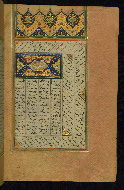
- Title: Incipit with illuminated headpiece and titlepiece
- Form: Incipit; headpiece; titlepiece
- Text: Laylá va Majnūn
- Label: This incipit page has an illuminated headpiece and, in the lower panel, a titlepiece inscribed Laylá va Majnūn.
fol. 110b:
fol. 118b:
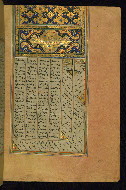
- Title: Incipit with illuminated headpiece and titlepiece
- Form: Incipit; headpiece; titlepiece
- Label: This incipit page has an illuminated headpiece and titlepiece. Above is a two-tiered illumination inscribed Allāhu wa-lā siwāhu. Below, at the right, are two small rectagular pieces insscribed: Majnūn Laylá-i Amīr Khusraw.
fol. 120a:
fol. 138a:
fol. 152a:
fol. 152b:
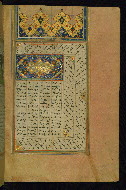
- Title: Incipit with illuminated headpiece and titlepiece
- Form: Incipit; headpiece; titlepiece
- Label: This incipit page has an illuminated titepiece inscribed: Haft paykar-i Shaykh-i Niẓāmī in white ink.
fol. 153a:
fol. 159b:
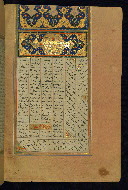
- Title: Incipit with illuminated titlepiece
- Form: Incipit; titlepiece
- Label: This illuminated incipit page has a large titlepiece inscribed: huwa Allāhu subḥānahu. On the right side, below the titlepiece, three triangles are inscribed: Hasht bihisht-i Amīr Khusraw.
fol. 174a:
fol. 180a:
fol. 182b:
fol. 185b:
fol. 189b:
fol. 194b:
fol. 199a:
fol. 210b:
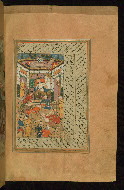
- Title: Bahrām Gūr watching justice being served to a man and a woman
- Form: Illustration
- Text: Haft paykar
fol. 211a:
fol. 211b:
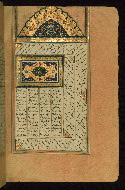
- Title: Incipit with illuminated headpiece and titlepiece
- Form: Incipit; headpiece; titlepiece
- Text: Iqbālnāmah
- Label: This incipit page has several illuminated pieces. The titlepiece is inscribed: Iqbālnāmah-i Iskandarī.
fol. 214b:
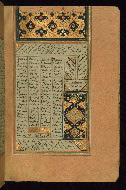
- Title: Incipit with illuminated headpiece and titlepiece
- Form: Incipit; headpiece; titlepiece
- Label: This incipit page has several illuminated pieces. In the illuminated panels at the lower right is inscribed: Āyinah-i Iskandarī-i Amīr Khusraw.
fol. 227a:
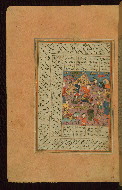
- Title: Alexander the Great (Iskandar) fighting the Zanghis (Ethiopians)
- Form: Illustration
- Text: Iskandarnāmah
fol. 280a:
fol. 280b:
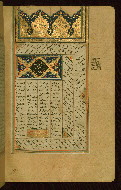
- Title: Incipit with illuminated headpiece and titlepiece
- Form: Incipit; headpiece; titlepiece
- Text: Khirdnāmah
- Label: This incipit page has a number of illuminated pieces, including a titlepiece inscribed: Khirdnāmah-i Iskandari-i Niẓāmī.
fol. 282b:
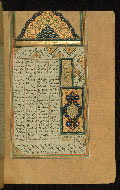
- Title: Incipit with illuminated pieces
- Form: Incipit; headpiece; titlepiece; tailpiece
- Label: This illuminated incipit page has a headpiece in the form of a dome and two rectangular pieces below, one of which is a tailpiece for the end of Khamsah-i Amīr Khusraw; the other has the inscription: Timurnāmah-i Hātifī ʿalayhi al-raḥmah.
fol. 304b:
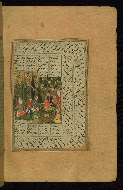
- Title: Alexander the Great (Iskandar) being handed a letter that describes a dangerous passage through the mountains
- Form: Illustration
- Text: Iskandarnāmah
fol. 329b:
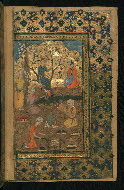
- Title: Illustrated finispiece
- Form: Illustration; finispiece
- Label: This is the right side of a double-page illustrated finispiece.
fol. 330a:
The binding is not original.
Red leather with central medallion, pendants, and cornerpieces (no flap); gold-painted arabesque decoration; re-bound and restored by a bookbinder of Tabriz, Khwand Mullā Mahdī Ṣaḥḥāf-i Tabrīzī (see note, signed and dated 1295 AH / 1878 CE on front flyleaf iia)
Note regarding re-binding and restoration of this volume by a bookbinder of Tabriz, Khwand Mullā Mahdī Ṣaḥḥāf-i Tabrīzī, signed and dated 1295 AH / 1878 CE (front flyleaf iia)
Seal impression with motto containing the name Munḏir (fol. 280b)
Walters Art Museum, 1931, by Henry Walters bequest
Richard, Francis. Catalogue des manuscrits persans. (Paris: Bibliothèque nationale, 1989), nos. 232-4. (Timūrnāmah-i Hātifi)
Gacek, Adam. Persian Manuscripts in the Libraries of McGill University: Brief Union Catalogue. (Montreal: McGill University Libraries, 2005), no 110. (Khamsah-i Dihlavī)
Gacek, Adam. Persian Manuscripts in the Libraries of McGill University: Brief Union Catalogue. (Montreal: McGill University Libraries, 2005), no. 111.
Storey, C. A. Persian Literature: A Bio-Bibliographical Survey, Vol. 2. (London: Luzac, 1927- ), 438-495. (Khamsah-i Niẓāmī)
Principal cataloger: Gacek, Adam
Catalogers: Landau, Amy; Smith, Sita
Editor: Bockrath, Diane
Conservators: Jewell, Stephanie; Quandt, Abigail
Contributors: Barrera, Christina; Emery, Doug; Herbert, Lynley; Noel, William; Simpson, Shreve; Tabritha, Ariel; Toth, Michael B.; Valle, Chiara
The Walters Art Museum
Licensed for use under Creative Commons Attribution-NonCommercial-ShareAlike 3.0 Unported Access Rights, http://creativecommons.org/licenses/by-nc-sa/3.0/legalcode. It is requested that copies of any published articles based on the information in this data set be sent to the curator of manuscripts, The Walters Art Museum, 600 North Charles Street, Baltimore MD 21201.
